HSC230: Implementing a Cultural Safety Action Plan in Healthcare
VerifiedAdded on 2023/04/26
|8
|2296
|288
Report
AI Summary
This report presents a personal action plan for implementing cultural safety practices within healthcare organizations, focusing on improving the wellbeing of Aboriginal and Torres Strait Islander populations. The plan outlines goals, objectives, resource requirements, and anticipated barriers, such as the prevalence of 'whiteness' ideologies and potential resistance from healthcare staff. Strategies for overcoming these barriers include building relationships with community elders and implementing stakeholder buy-in programs. The rationale behind the action plan emphasizes the need to address health inequalities and improve access to culturally safe healthcare services for indigenous people through collaboration, inclusion, and a relationship-based care approach. Progress evaluation will be conducted using surveys and scorecards to ensure the action plan's efficacy and to identify areas for improvement. Desklib provides this document as a valuable resource for students.
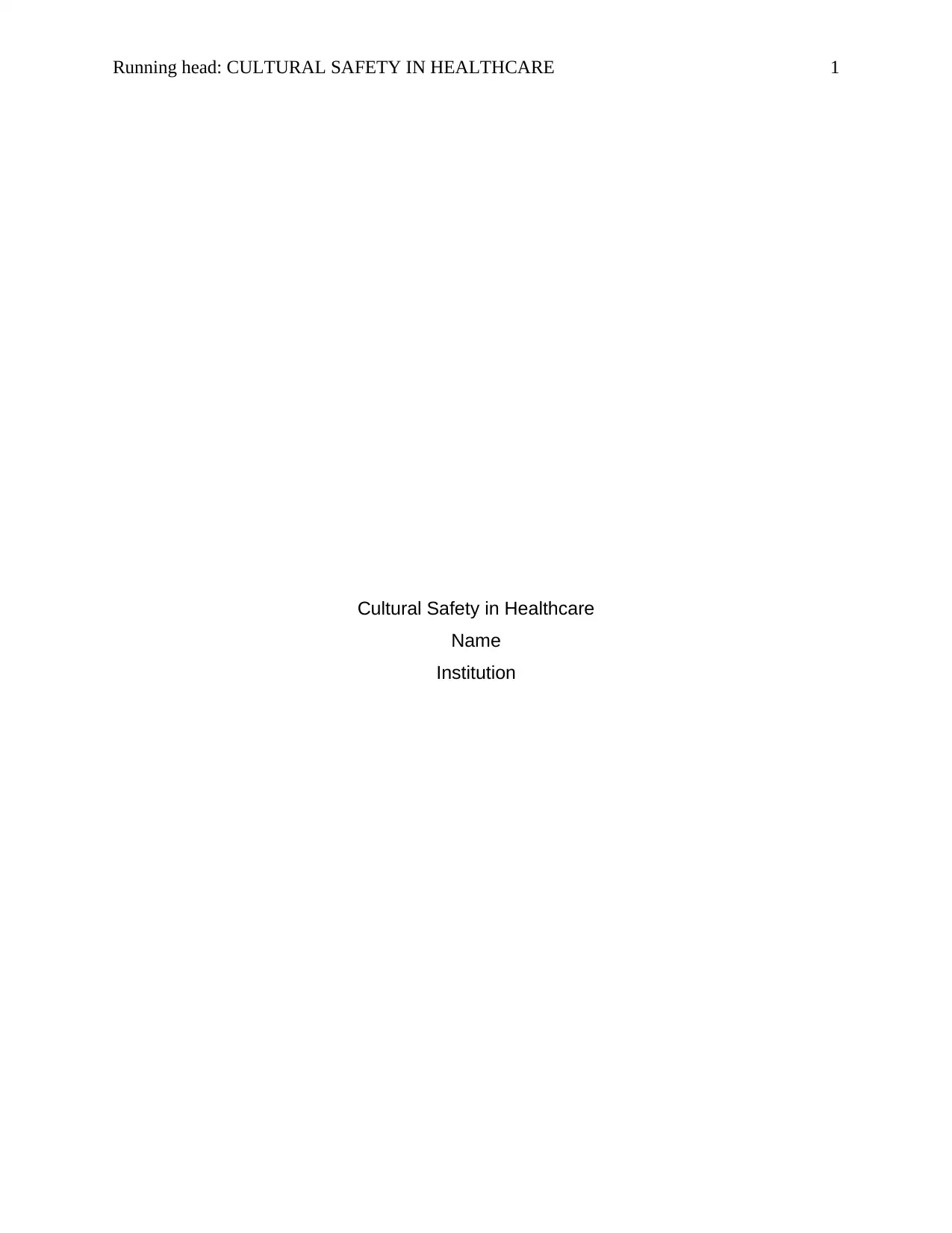
Running head: CULTURAL SAFETY IN HEALTHCARE 1
Cultural Safety in Healthcare
Name
Institution
Cultural Safety in Healthcare
Name
Institution
Paraphrase This Document
Need a fresh take? Get an instant paraphrase of this document with our AI Paraphraser
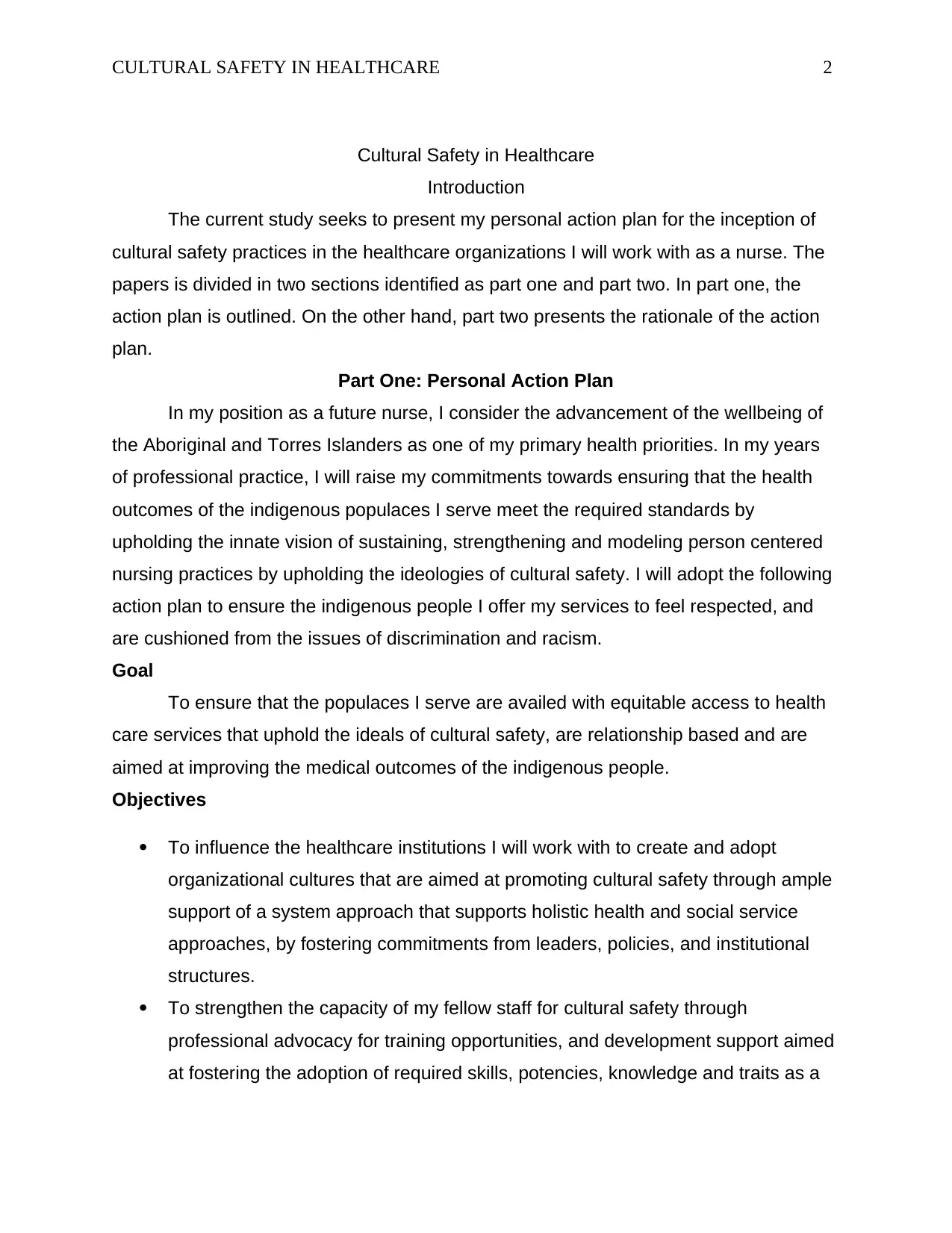
CULTURAL SAFETY IN HEALTHCARE 2
Cultural Safety in Healthcare
Introduction
The current study seeks to present my personal action plan for the inception of
cultural safety practices in the healthcare organizations I will work with as a nurse. The
papers is divided in two sections identified as part one and part two. In part one, the
action plan is outlined. On the other hand, part two presents the rationale of the action
plan.
Part One: Personal Action Plan
In my position as a future nurse, I consider the advancement of the wellbeing of
the Aboriginal and Torres Islanders as one of my primary health priorities. In my years
of professional practice, I will raise my commitments towards ensuring that the health
outcomes of the indigenous populaces I serve meet the required standards by
upholding the innate vision of sustaining, strengthening and modeling person centered
nursing practices by upholding the ideologies of cultural safety. I will adopt the following
action plan to ensure the indigenous people I offer my services to feel respected, and
are cushioned from the issues of discrimination and racism.
Goal
To ensure that the populaces I serve are availed with equitable access to health
care services that uphold the ideals of cultural safety, are relationship based and are
aimed at improving the medical outcomes of the indigenous people.
Objectives
To influence the healthcare institutions I will work with to create and adopt
organizational cultures that are aimed at promoting cultural safety through ample
support of a system approach that supports holistic health and social service
approaches, by fostering commitments from leaders, policies, and institutional
structures.
To strengthen the capacity of my fellow staff for cultural safety through
professional advocacy for training opportunities, and development support aimed
at fostering the adoption of required skills, potencies, knowledge and traits as a
Cultural Safety in Healthcare
Introduction
The current study seeks to present my personal action plan for the inception of
cultural safety practices in the healthcare organizations I will work with as a nurse. The
papers is divided in two sections identified as part one and part two. In part one, the
action plan is outlined. On the other hand, part two presents the rationale of the action
plan.
Part One: Personal Action Plan
In my position as a future nurse, I consider the advancement of the wellbeing of
the Aboriginal and Torres Islanders as one of my primary health priorities. In my years
of professional practice, I will raise my commitments towards ensuring that the health
outcomes of the indigenous populaces I serve meet the required standards by
upholding the innate vision of sustaining, strengthening and modeling person centered
nursing practices by upholding the ideologies of cultural safety. I will adopt the following
action plan to ensure the indigenous people I offer my services to feel respected, and
are cushioned from the issues of discrimination and racism.
Goal
To ensure that the populaces I serve are availed with equitable access to health
care services that uphold the ideals of cultural safety, are relationship based and are
aimed at improving the medical outcomes of the indigenous people.
Objectives
To influence the healthcare institutions I will work with to create and adopt
organizational cultures that are aimed at promoting cultural safety through ample
support of a system approach that supports holistic health and social service
approaches, by fostering commitments from leaders, policies, and institutional
structures.
To strengthen the capacity of my fellow staff for cultural safety through
professional advocacy for training opportunities, and development support aimed
at fostering the adoption of required skills, potencies, knowledge and traits as a
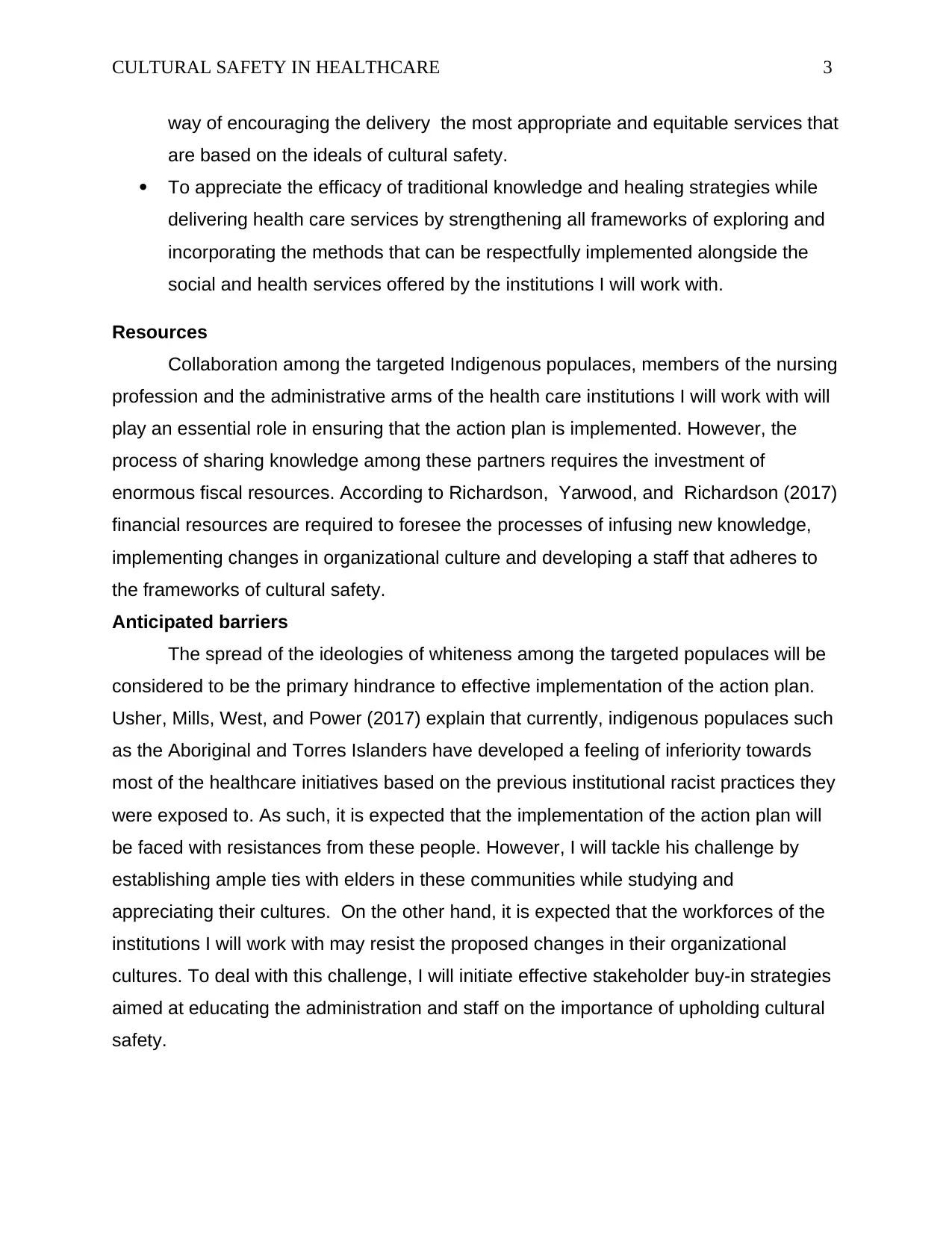
CULTURAL SAFETY IN HEALTHCARE 3
way of encouraging the delivery the most appropriate and equitable services that
are based on the ideals of cultural safety.
To appreciate the efficacy of traditional knowledge and healing strategies while
delivering health care services by strengthening all frameworks of exploring and
incorporating the methods that can be respectfully implemented alongside the
social and health services offered by the institutions I will work with.
Resources
Collaboration among the targeted Indigenous populaces, members of the nursing
profession and the administrative arms of the health care institutions I will work with will
play an essential role in ensuring that the action plan is implemented. However, the
process of sharing knowledge among these partners requires the investment of
enormous fiscal resources. According to Richardson, Yarwood, and Richardson (2017)
financial resources are required to foresee the processes of infusing new knowledge,
implementing changes in organizational culture and developing a staff that adheres to
the frameworks of cultural safety.
Anticipated barriers
The spread of the ideologies of whiteness among the targeted populaces will be
considered to be the primary hindrance to effective implementation of the action plan.
Usher, Mills, West, and Power (2017) explain that currently, indigenous populaces such
as the Aboriginal and Torres Islanders have developed a feeling of inferiority towards
most of the healthcare initiatives based on the previous institutional racist practices they
were exposed to. As such, it is expected that the implementation of the action plan will
be faced with resistances from these people. However, I will tackle his challenge by
establishing ample ties with elders in these communities while studying and
appreciating their cultures. On the other hand, it is expected that the workforces of the
institutions I will work with may resist the proposed changes in their organizational
cultures. To deal with this challenge, I will initiate effective stakeholder buy-in strategies
aimed at educating the administration and staff on the importance of upholding cultural
safety.
way of encouraging the delivery the most appropriate and equitable services that
are based on the ideals of cultural safety.
To appreciate the efficacy of traditional knowledge and healing strategies while
delivering health care services by strengthening all frameworks of exploring and
incorporating the methods that can be respectfully implemented alongside the
social and health services offered by the institutions I will work with.
Resources
Collaboration among the targeted Indigenous populaces, members of the nursing
profession and the administrative arms of the health care institutions I will work with will
play an essential role in ensuring that the action plan is implemented. However, the
process of sharing knowledge among these partners requires the investment of
enormous fiscal resources. According to Richardson, Yarwood, and Richardson (2017)
financial resources are required to foresee the processes of infusing new knowledge,
implementing changes in organizational culture and developing a staff that adheres to
the frameworks of cultural safety.
Anticipated barriers
The spread of the ideologies of whiteness among the targeted populaces will be
considered to be the primary hindrance to effective implementation of the action plan.
Usher, Mills, West, and Power (2017) explain that currently, indigenous populaces such
as the Aboriginal and Torres Islanders have developed a feeling of inferiority towards
most of the healthcare initiatives based on the previous institutional racist practices they
were exposed to. As such, it is expected that the implementation of the action plan will
be faced with resistances from these people. However, I will tackle his challenge by
establishing ample ties with elders in these communities while studying and
appreciating their cultures. On the other hand, it is expected that the workforces of the
institutions I will work with may resist the proposed changes in their organizational
cultures. To deal with this challenge, I will initiate effective stakeholder buy-in strategies
aimed at educating the administration and staff on the importance of upholding cultural
safety.
⊘ This is a preview!⊘
Do you want full access?
Subscribe today to unlock all pages.

Trusted by 1+ million students worldwide
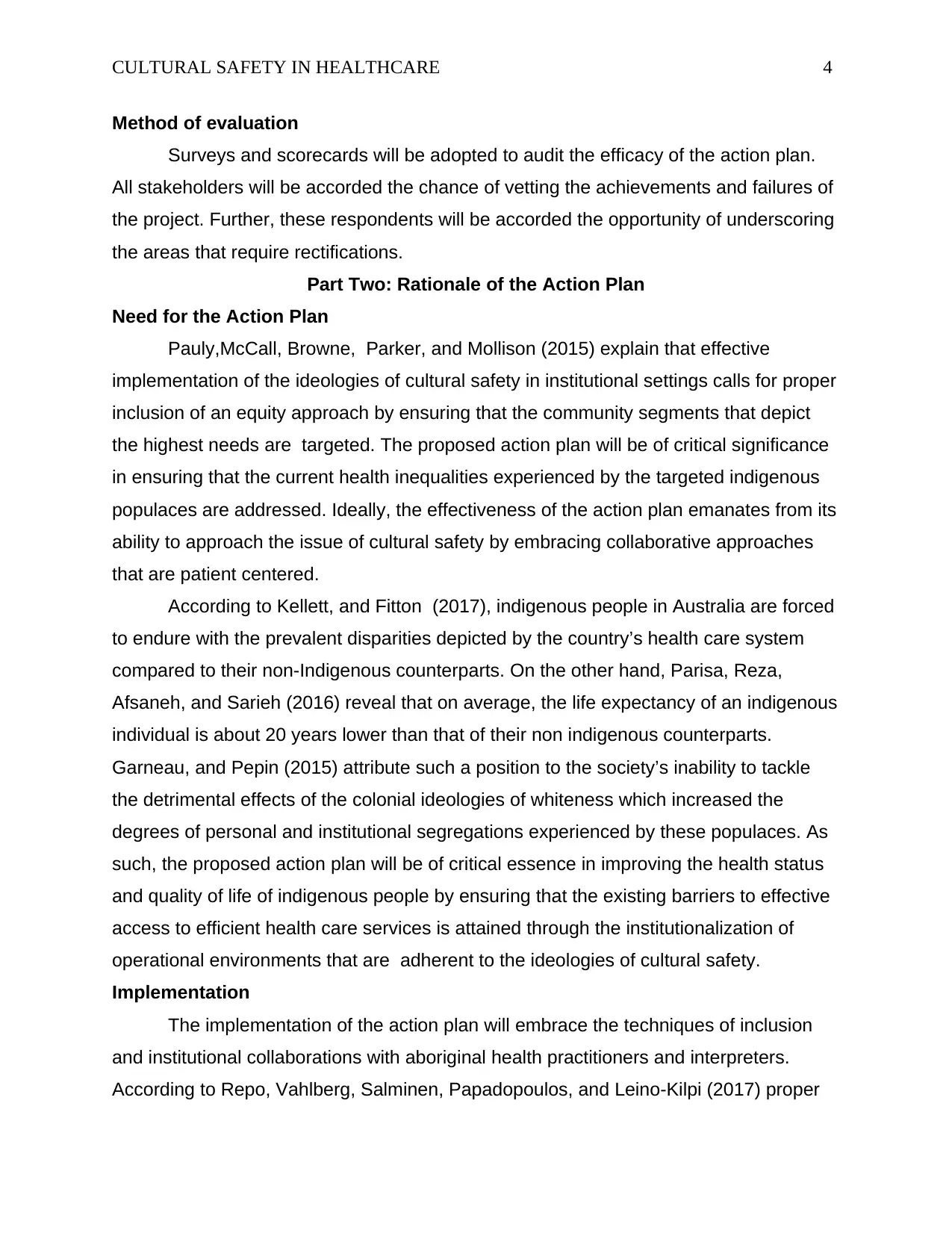
CULTURAL SAFETY IN HEALTHCARE 4
Method of evaluation
Surveys and scorecards will be adopted to audit the efficacy of the action plan.
All stakeholders will be accorded the chance of vetting the achievements and failures of
the project. Further, these respondents will be accorded the opportunity of underscoring
the areas that require rectifications.
Part Two: Rationale of the Action Plan
Need for the Action Plan
Pauly,McCall, Browne, Parker, and Mollison (2015) explain that effective
implementation of the ideologies of cultural safety in institutional settings calls for proper
inclusion of an equity approach by ensuring that the community segments that depict
the highest needs are targeted. The proposed action plan will be of critical significance
in ensuring that the current health inequalities experienced by the targeted indigenous
populaces are addressed. Ideally, the effectiveness of the action plan emanates from its
ability to approach the issue of cultural safety by embracing collaborative approaches
that are patient centered.
According to Kellett, and Fitton (2017), indigenous people in Australia are forced
to endure with the prevalent disparities depicted by the country’s health care system
compared to their non-Indigenous counterparts. On the other hand, Parisa, Reza,
Afsaneh, and Sarieh (2016) reveal that on average, the life expectancy of an indigenous
individual is about 20 years lower than that of their non indigenous counterparts.
Garneau, and Pepin (2015) attribute such a position to the society’s inability to tackle
the detrimental effects of the colonial ideologies of whiteness which increased the
degrees of personal and institutional segregations experienced by these populaces. As
such, the proposed action plan will be of critical essence in improving the health status
and quality of life of indigenous people by ensuring that the existing barriers to effective
access to efficient health care services is attained through the institutionalization of
operational environments that are adherent to the ideologies of cultural safety.
Implementation
The implementation of the action plan will embrace the techniques of inclusion
and institutional collaborations with aboriginal health practitioners and interpreters.
According to Repo, Vahlberg, Salminen, Papadopoulos, and Leino-Kilpi (2017) proper
Method of evaluation
Surveys and scorecards will be adopted to audit the efficacy of the action plan.
All stakeholders will be accorded the chance of vetting the achievements and failures of
the project. Further, these respondents will be accorded the opportunity of underscoring
the areas that require rectifications.
Part Two: Rationale of the Action Plan
Need for the Action Plan
Pauly,McCall, Browne, Parker, and Mollison (2015) explain that effective
implementation of the ideologies of cultural safety in institutional settings calls for proper
inclusion of an equity approach by ensuring that the community segments that depict
the highest needs are targeted. The proposed action plan will be of critical significance
in ensuring that the current health inequalities experienced by the targeted indigenous
populaces are addressed. Ideally, the effectiveness of the action plan emanates from its
ability to approach the issue of cultural safety by embracing collaborative approaches
that are patient centered.
According to Kellett, and Fitton (2017), indigenous people in Australia are forced
to endure with the prevalent disparities depicted by the country’s health care system
compared to their non-Indigenous counterparts. On the other hand, Parisa, Reza,
Afsaneh, and Sarieh (2016) reveal that on average, the life expectancy of an indigenous
individual is about 20 years lower than that of their non indigenous counterparts.
Garneau, and Pepin (2015) attribute such a position to the society’s inability to tackle
the detrimental effects of the colonial ideologies of whiteness which increased the
degrees of personal and institutional segregations experienced by these populaces. As
such, the proposed action plan will be of critical essence in improving the health status
and quality of life of indigenous people by ensuring that the existing barriers to effective
access to efficient health care services is attained through the institutionalization of
operational environments that are adherent to the ideologies of cultural safety.
Implementation
The implementation of the action plan will embrace the techniques of inclusion
and institutional collaborations with aboriginal health practitioners and interpreters.
According to Repo, Vahlberg, Salminen, Papadopoulos, and Leino-Kilpi (2017) proper
Paraphrase This Document
Need a fresh take? Get an instant paraphrase of this document with our AI Paraphraser
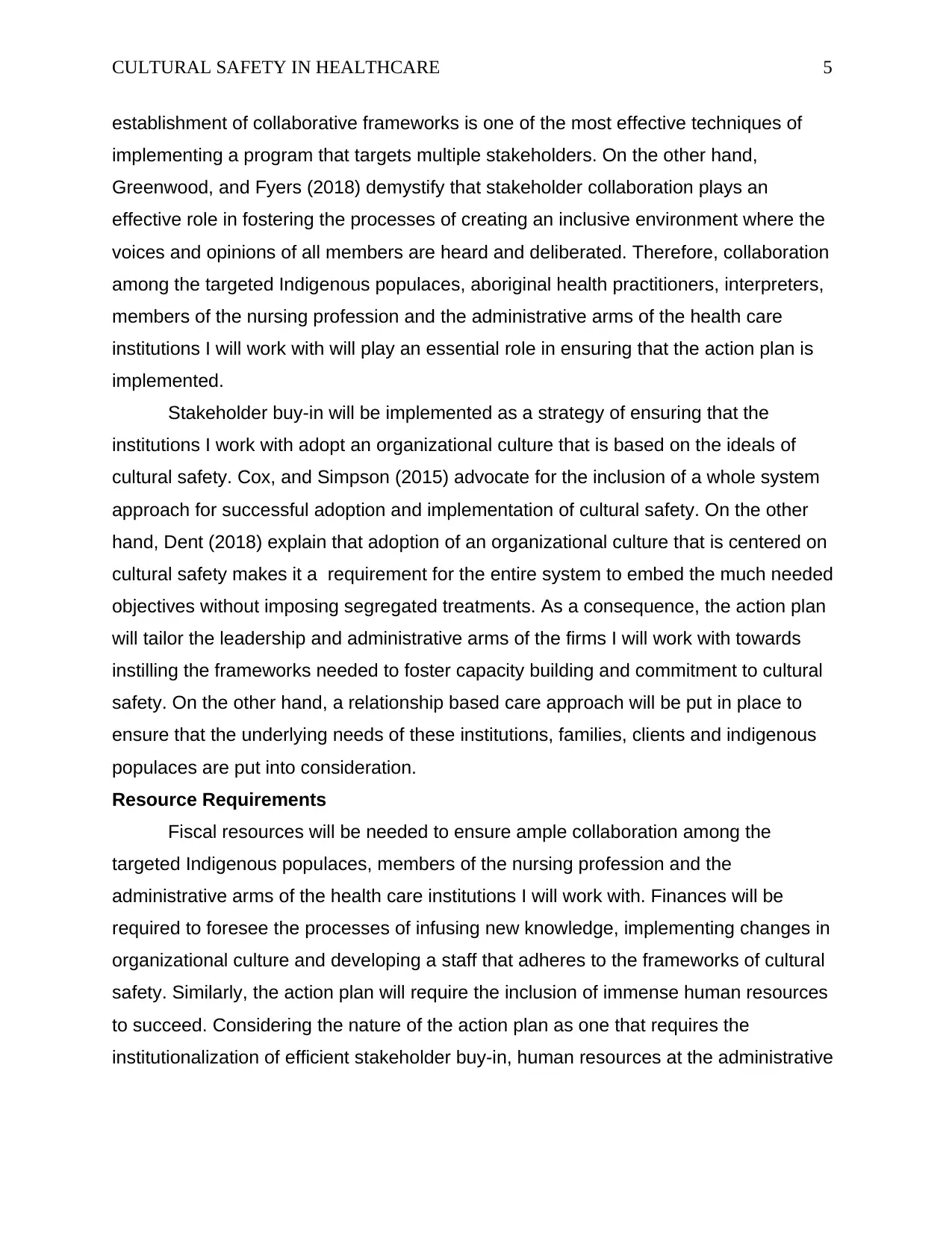
CULTURAL SAFETY IN HEALTHCARE 5
establishment of collaborative frameworks is one of the most effective techniques of
implementing a program that targets multiple stakeholders. On the other hand,
Greenwood, and Fyers (2018) demystify that stakeholder collaboration plays an
effective role in fostering the processes of creating an inclusive environment where the
voices and opinions of all members are heard and deliberated. Therefore, collaboration
among the targeted Indigenous populaces, aboriginal health practitioners, interpreters,
members of the nursing profession and the administrative arms of the health care
institutions I will work with will play an essential role in ensuring that the action plan is
implemented.
Stakeholder buy-in will be implemented as a strategy of ensuring that the
institutions I work with adopt an organizational culture that is based on the ideals of
cultural safety. Cox, and Simpson (2015) advocate for the inclusion of a whole system
approach for successful adoption and implementation of cultural safety. On the other
hand, Dent (2018) explain that adoption of an organizational culture that is centered on
cultural safety makes it a requirement for the entire system to embed the much needed
objectives without imposing segregated treatments. As a consequence, the action plan
will tailor the leadership and administrative arms of the firms I will work with towards
instilling the frameworks needed to foster capacity building and commitment to cultural
safety. On the other hand, a relationship based care approach will be put in place to
ensure that the underlying needs of these institutions, families, clients and indigenous
populaces are put into consideration.
Resource Requirements
Fiscal resources will be needed to ensure ample collaboration among the
targeted Indigenous populaces, members of the nursing profession and the
administrative arms of the health care institutions I will work with. Finances will be
required to foresee the processes of infusing new knowledge, implementing changes in
organizational culture and developing a staff that adheres to the frameworks of cultural
safety. Similarly, the action plan will require the inclusion of immense human resources
to succeed. Considering the nature of the action plan as one that requires the
institutionalization of efficient stakeholder buy-in, human resources at the administrative
establishment of collaborative frameworks is one of the most effective techniques of
implementing a program that targets multiple stakeholders. On the other hand,
Greenwood, and Fyers (2018) demystify that stakeholder collaboration plays an
effective role in fostering the processes of creating an inclusive environment where the
voices and opinions of all members are heard and deliberated. Therefore, collaboration
among the targeted Indigenous populaces, aboriginal health practitioners, interpreters,
members of the nursing profession and the administrative arms of the health care
institutions I will work with will play an essential role in ensuring that the action plan is
implemented.
Stakeholder buy-in will be implemented as a strategy of ensuring that the
institutions I work with adopt an organizational culture that is based on the ideals of
cultural safety. Cox, and Simpson (2015) advocate for the inclusion of a whole system
approach for successful adoption and implementation of cultural safety. On the other
hand, Dent (2018) explain that adoption of an organizational culture that is centered on
cultural safety makes it a requirement for the entire system to embed the much needed
objectives without imposing segregated treatments. As a consequence, the action plan
will tailor the leadership and administrative arms of the firms I will work with towards
instilling the frameworks needed to foster capacity building and commitment to cultural
safety. On the other hand, a relationship based care approach will be put in place to
ensure that the underlying needs of these institutions, families, clients and indigenous
populaces are put into consideration.
Resource Requirements
Fiscal resources will be needed to ensure ample collaboration among the
targeted Indigenous populaces, members of the nursing profession and the
administrative arms of the health care institutions I will work with. Finances will be
required to foresee the processes of infusing new knowledge, implementing changes in
organizational culture and developing a staff that adheres to the frameworks of cultural
safety. Similarly, the action plan will require the inclusion of immense human resources
to succeed. Considering the nature of the action plan as one that requires the
institutionalization of efficient stakeholder buy-in, human resources at the administrative
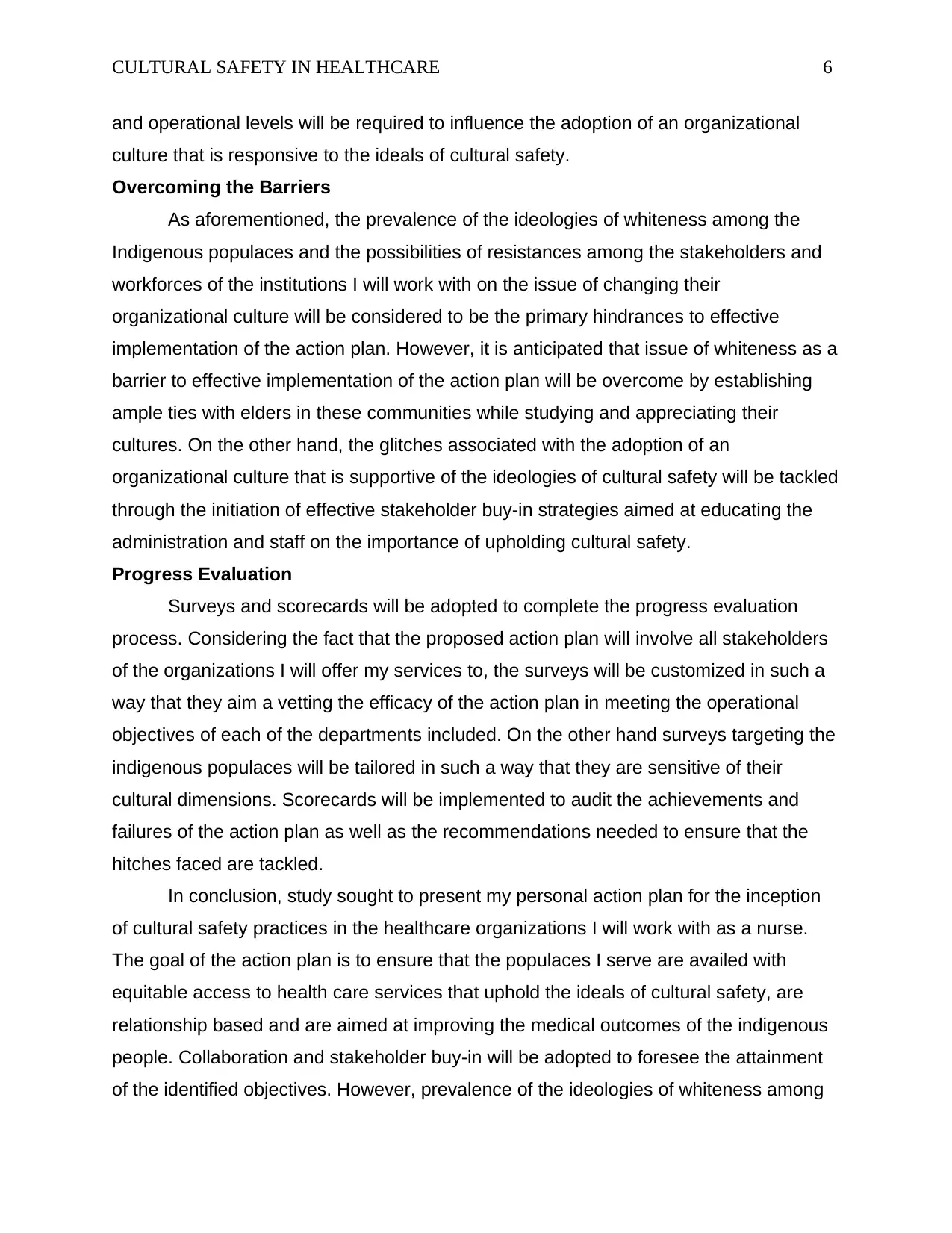
CULTURAL SAFETY IN HEALTHCARE 6
and operational levels will be required to influence the adoption of an organizational
culture that is responsive to the ideals of cultural safety.
Overcoming the Barriers
As aforementioned, the prevalence of the ideologies of whiteness among the
Indigenous populaces and the possibilities of resistances among the stakeholders and
workforces of the institutions I will work with on the issue of changing their
organizational culture will be considered to be the primary hindrances to effective
implementation of the action plan. However, it is anticipated that issue of whiteness as a
barrier to effective implementation of the action plan will be overcome by establishing
ample ties with elders in these communities while studying and appreciating their
cultures. On the other hand, the glitches associated with the adoption of an
organizational culture that is supportive of the ideologies of cultural safety will be tackled
through the initiation of effective stakeholder buy-in strategies aimed at educating the
administration and staff on the importance of upholding cultural safety.
Progress Evaluation
Surveys and scorecards will be adopted to complete the progress evaluation
process. Considering the fact that the proposed action plan will involve all stakeholders
of the organizations I will offer my services to, the surveys will be customized in such a
way that they aim a vetting the efficacy of the action plan in meeting the operational
objectives of each of the departments included. On the other hand surveys targeting the
indigenous populaces will be tailored in such a way that they are sensitive of their
cultural dimensions. Scorecards will be implemented to audit the achievements and
failures of the action plan as well as the recommendations needed to ensure that the
hitches faced are tackled.
In conclusion, study sought to present my personal action plan for the inception
of cultural safety practices in the healthcare organizations I will work with as a nurse.
The goal of the action plan is to ensure that the populaces I serve are availed with
equitable access to health care services that uphold the ideals of cultural safety, are
relationship based and are aimed at improving the medical outcomes of the indigenous
people. Collaboration and stakeholder buy-in will be adopted to foresee the attainment
of the identified objectives. However, prevalence of the ideologies of whiteness among
and operational levels will be required to influence the adoption of an organizational
culture that is responsive to the ideals of cultural safety.
Overcoming the Barriers
As aforementioned, the prevalence of the ideologies of whiteness among the
Indigenous populaces and the possibilities of resistances among the stakeholders and
workforces of the institutions I will work with on the issue of changing their
organizational culture will be considered to be the primary hindrances to effective
implementation of the action plan. However, it is anticipated that issue of whiteness as a
barrier to effective implementation of the action plan will be overcome by establishing
ample ties with elders in these communities while studying and appreciating their
cultures. On the other hand, the glitches associated with the adoption of an
organizational culture that is supportive of the ideologies of cultural safety will be tackled
through the initiation of effective stakeholder buy-in strategies aimed at educating the
administration and staff on the importance of upholding cultural safety.
Progress Evaluation
Surveys and scorecards will be adopted to complete the progress evaluation
process. Considering the fact that the proposed action plan will involve all stakeholders
of the organizations I will offer my services to, the surveys will be customized in such a
way that they aim a vetting the efficacy of the action plan in meeting the operational
objectives of each of the departments included. On the other hand surveys targeting the
indigenous populaces will be tailored in such a way that they are sensitive of their
cultural dimensions. Scorecards will be implemented to audit the achievements and
failures of the action plan as well as the recommendations needed to ensure that the
hitches faced are tackled.
In conclusion, study sought to present my personal action plan for the inception
of cultural safety practices in the healthcare organizations I will work with as a nurse.
The goal of the action plan is to ensure that the populaces I serve are availed with
equitable access to health care services that uphold the ideals of cultural safety, are
relationship based and are aimed at improving the medical outcomes of the indigenous
people. Collaboration and stakeholder buy-in will be adopted to foresee the attainment
of the identified objectives. However, prevalence of the ideologies of whiteness among
⊘ This is a preview!⊘
Do you want full access?
Subscribe today to unlock all pages.

Trusted by 1+ million students worldwide
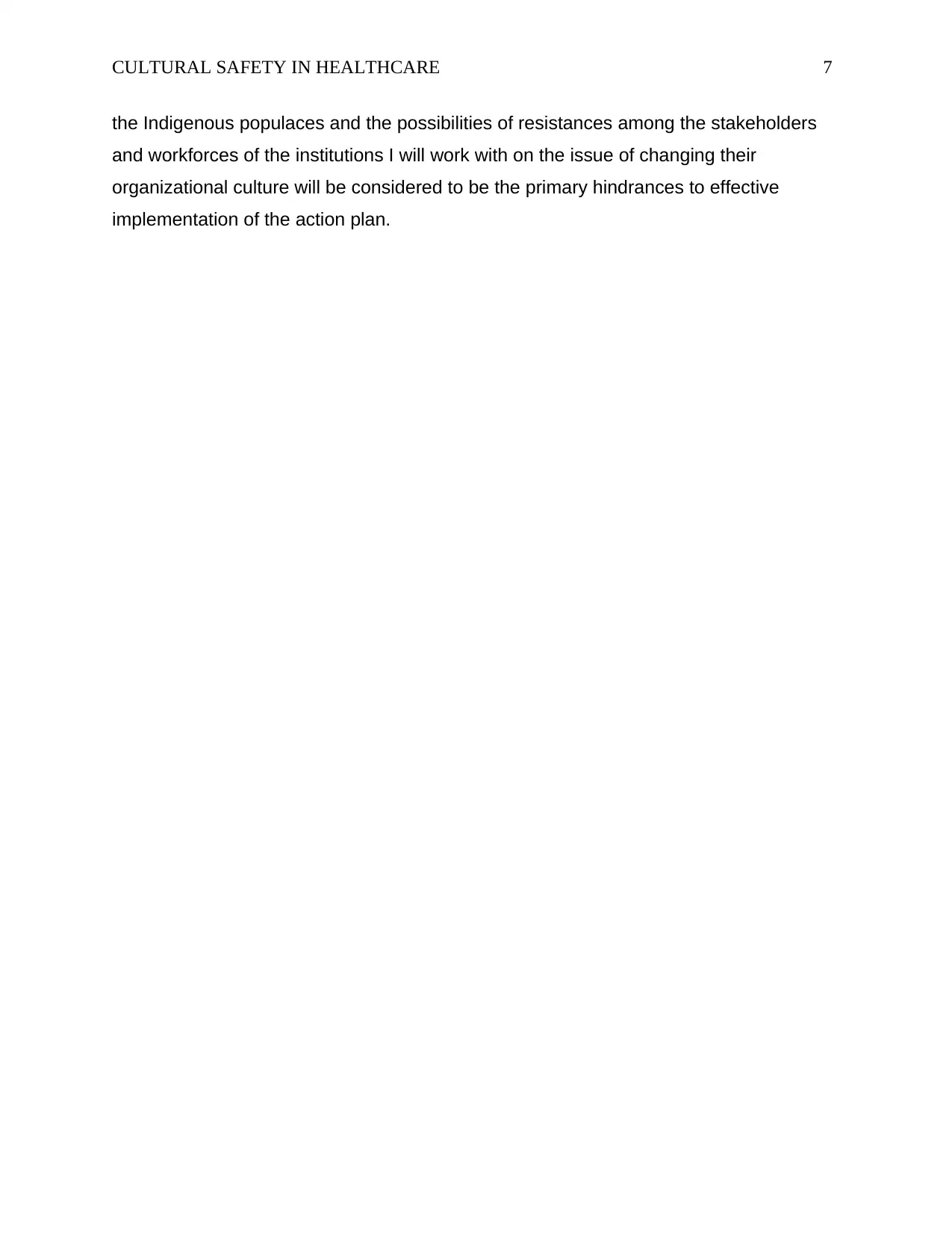
CULTURAL SAFETY IN HEALTHCARE 7
the Indigenous populaces and the possibilities of resistances among the stakeholders
and workforces of the institutions I will work with on the issue of changing their
organizational culture will be considered to be the primary hindrances to effective
implementation of the action plan.
the Indigenous populaces and the possibilities of resistances among the stakeholders
and workforces of the institutions I will work with on the issue of changing their
organizational culture will be considered to be the primary hindrances to effective
implementation of the action plan.
Paraphrase This Document
Need a fresh take? Get an instant paraphrase of this document with our AI Paraphraser
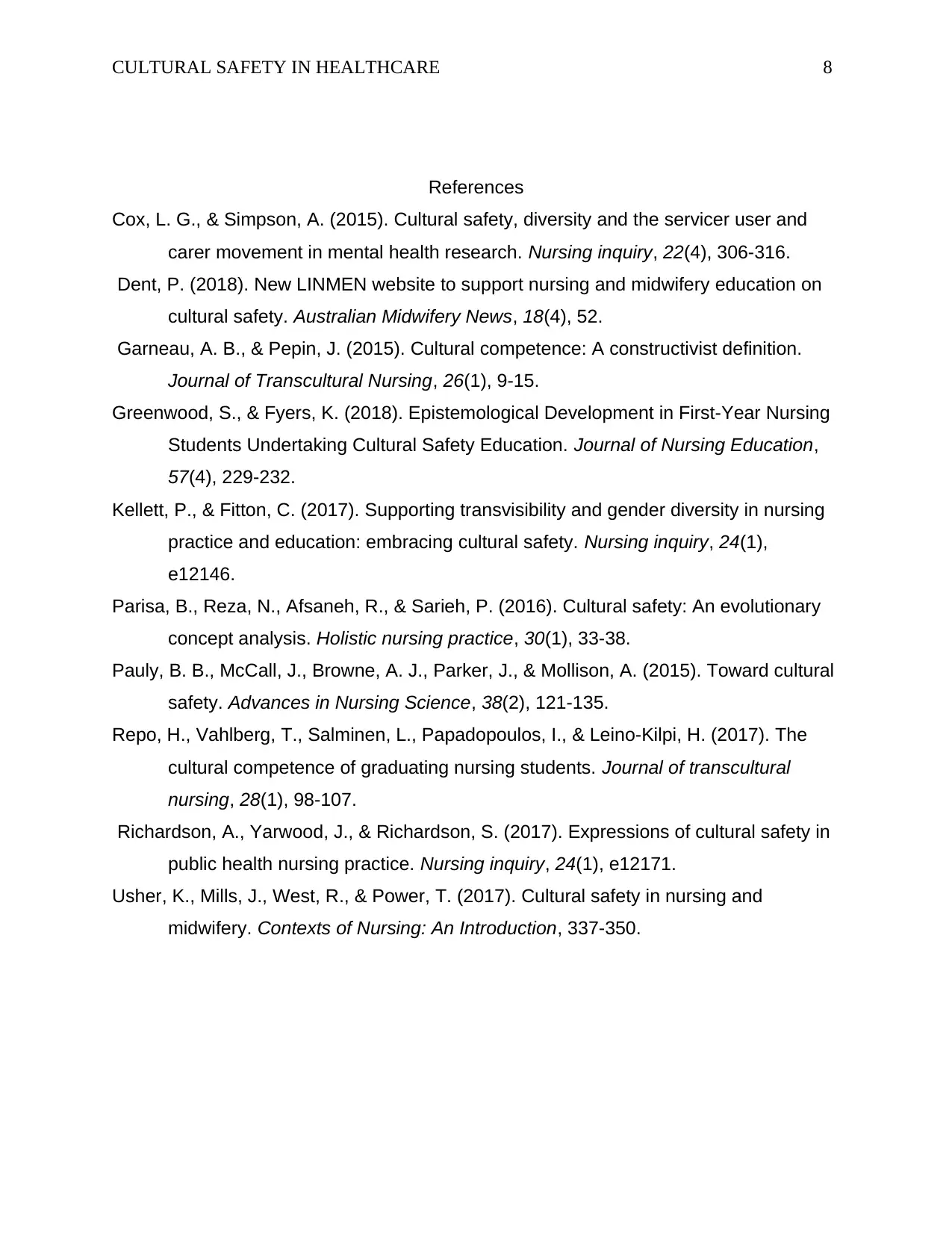
CULTURAL SAFETY IN HEALTHCARE 8
References
Cox, L. G., & Simpson, A. (2015). Cultural safety, diversity and the servicer user and
carer movement in mental health research. Nursing inquiry, 22(4), 306-316.
Dent, P. (2018). New LINMEN website to support nursing and midwifery education on
cultural safety. Australian Midwifery News, 18(4), 52.
Garneau, A. B., & Pepin, J. (2015). Cultural competence: A constructivist definition.
Journal of Transcultural Nursing, 26(1), 9-15.
Greenwood, S., & Fyers, K. (2018). Epistemological Development in First-Year Nursing
Students Undertaking Cultural Safety Education. Journal of Nursing Education,
57(4), 229-232.
Kellett, P., & Fitton, C. (2017). Supporting transvisibility and gender diversity in nursing
practice and education: embracing cultural safety. Nursing inquiry, 24(1),
e12146.
Parisa, B., Reza, N., Afsaneh, R., & Sarieh, P. (2016). Cultural safety: An evolutionary
concept analysis. Holistic nursing practice, 30(1), 33-38.
Pauly, B. B., McCall, J., Browne, A. J., Parker, J., & Mollison, A. (2015). Toward cultural
safety. Advances in Nursing Science, 38(2), 121-135.
Repo, H., Vahlberg, T., Salminen, L., Papadopoulos, I., & Leino-Kilpi, H. (2017). The
cultural competence of graduating nursing students. Journal of transcultural
nursing, 28(1), 98-107.
Richardson, A., Yarwood, J., & Richardson, S. (2017). Expressions of cultural safety in
public health nursing practice. Nursing inquiry, 24(1), e12171.
Usher, K., Mills, J., West, R., & Power, T. (2017). Cultural safety in nursing and
midwifery. Contexts of Nursing: An Introduction, 337-350.
References
Cox, L. G., & Simpson, A. (2015). Cultural safety, diversity and the servicer user and
carer movement in mental health research. Nursing inquiry, 22(4), 306-316.
Dent, P. (2018). New LINMEN website to support nursing and midwifery education on
cultural safety. Australian Midwifery News, 18(4), 52.
Garneau, A. B., & Pepin, J. (2015). Cultural competence: A constructivist definition.
Journal of Transcultural Nursing, 26(1), 9-15.
Greenwood, S., & Fyers, K. (2018). Epistemological Development in First-Year Nursing
Students Undertaking Cultural Safety Education. Journal of Nursing Education,
57(4), 229-232.
Kellett, P., & Fitton, C. (2017). Supporting transvisibility and gender diversity in nursing
practice and education: embracing cultural safety. Nursing inquiry, 24(1),
e12146.
Parisa, B., Reza, N., Afsaneh, R., & Sarieh, P. (2016). Cultural safety: An evolutionary
concept analysis. Holistic nursing practice, 30(1), 33-38.
Pauly, B. B., McCall, J., Browne, A. J., Parker, J., & Mollison, A. (2015). Toward cultural
safety. Advances in Nursing Science, 38(2), 121-135.
Repo, H., Vahlberg, T., Salminen, L., Papadopoulos, I., & Leino-Kilpi, H. (2017). The
cultural competence of graduating nursing students. Journal of transcultural
nursing, 28(1), 98-107.
Richardson, A., Yarwood, J., & Richardson, S. (2017). Expressions of cultural safety in
public health nursing practice. Nursing inquiry, 24(1), e12171.
Usher, K., Mills, J., West, R., & Power, T. (2017). Cultural safety in nursing and
midwifery. Contexts of Nursing: An Introduction, 337-350.
1 out of 8
Related Documents
Your All-in-One AI-Powered Toolkit for Academic Success.
+13062052269
info@desklib.com
Available 24*7 on WhatsApp / Email
![[object Object]](/_next/static/media/star-bottom.7253800d.svg)
Unlock your academic potential
Copyright © 2020–2025 A2Z Services. All Rights Reserved. Developed and managed by ZUCOL.





